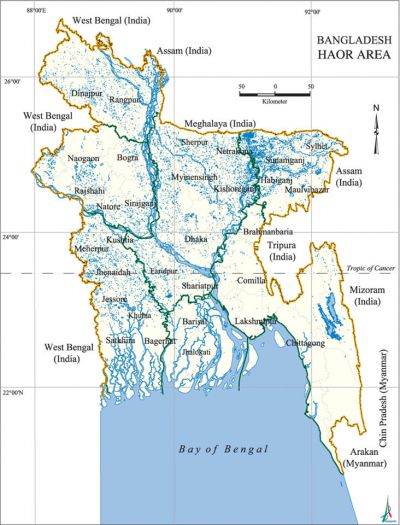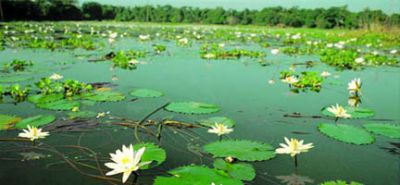Haor
Haor bowl-shaped large tectonic depression. It receives surface runoff water by rivers and khals, and consequently, a haor becomes very extensive water body in the monsoon and dries up mostly in the post-monsoon period. In Bangladesh haors are found mainly in greater Sylhet and greater Mymensingh regions. During monsoon a haor is a vast stretch of turbulent water. The word haor is a corrupt form of the Sanskrit word Sagar (sea). In Sylhet and northeast Mymensingh, the people pronounce the Bangla letter 'm' (sa) as 'n' (ha), and some times 'M' (ga) as 'n' (ha). Thus sagar is sounded haor.

The haors are of tectonic origin and possibly connected with the rise of madhupur tract. beels do not subside but haor basins do. In its original form, the haor basin comprising the floodplains of the meghna tributaries would have consisted of a rich mosaic of permanent and seasonal lakes and ponds with abundant aquatic vegetation. But through gradual sedimentation, the basin becomes shallower leading to the formation of reeds and sedges. This resulted in providing enough food and shelter for fish and other aquatic, fauna and attracted the migratory birds which, in their turn, added to the fertility of the waterbodies by their excreta promoting rich growth of phytoplankton and macrophytes thus partly contributing to the process of eutrophication.
The haor basin is bounded by the hill ranges of Meghalaya (India) on the north, the hills of Tripura and Mizoram (India) on the south, and the highlands of Manipur (India) on the east. The basin includes about 47 major haors and some 6,300 beels of varying size, out of which about 3,500 are permanent and 2,800 are seasonal. Numerous rivers rising in the hills of India provide an abundant supply of water to the plains and cause extensive flooding during the monsoon upto a depth of 6m. Small permanent water bodies within the haors are called beels, which occupy the lowest part of the depressions. During the dry season, most of the water drains out leaving one or more shallow beels which become mostly overgrown with aquatic vegetation or completely dry out by the end of dry season exposing rich alluvial soils extensively cultivated for rice.
The surma and kushiyara in association with other minor hilly streams like manu, khowai, Jadhukata, piyain, Mogra and Mahadao form the dense drainage network of the haors. The rivers are primarily responsible for providing inputs - rainwater and sediment load to the plains including haors. The plains remain flooded for about 7 to 8 months. During the rainy season, the haors turn into a vast inland sea within which the villages appear as islands. Occasional high winds during July to September generate large waves in the haor, which may cause considerable damage to homesteads.

The entire Sunamganj district, major portion of Habiganj district, some parts of Sylhet Sadar upazila and Maulvi Bazar district are covered by many haors. In greater Sylhet the most prominent haors are Saneer haor, Hail haor, Hakaluki haor, Dekar haor, Maker haor, Chayer haor, tanguar haor, and Kawadighi haor.
The haors are considered the most productive wetland resources of Bangladesh. The basin supports a large variety of wetland bio-diversity and works as natural reservoir as it plays a key role in basin water resources by regulating water flows of the Meghna river system. Also, the haors are noted sanctuaries of both permanent and migratory birds. With the recession of floodwater, a large variety of small fishes, oysters, water snails and bivalves, and pasture spread over the surface attracting a large number of migratory birds. These birds use the haor as temporary resting and roosting ground before moving elsewhere. The swamp forests, which were once dominant with the flood tolerant tree species like hijal (Barringtonia acutangula) and Koroch (Pongamia pinnata), have been reduced to a few small patches. The haors are also important fishing grounds of the country. In the past century or so, when the population pressure was less, most of the rim-lands of the haors remained as cultivable wasteland and was used for extensive grazing in the dry season. As population increased, boro cultivation expanded onto these marginal lands leading to a large area being drained. Thus, the very existences of these wetlands are now threatened. [Mohd Shamsul Alam and Md Sazzad Hossain]
